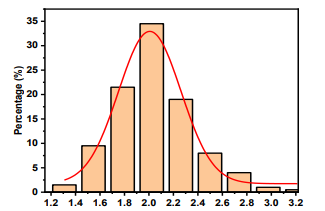Conjugation of Organic Dyes Onto pH Insensitive Silver Nanoparticles for pH Sensing
Keywords:
pH, Silver nanoparticles, NHS – 5(6) – carboxytetramethylrhodamine N-succinimidyl ester, (6) – carboxytetramethylrhodamine N-succinimidyl ester, Fluorescence, NanoprobeAbstract
pH is a very important parameter in research, production and quality assessment in the fields of life sciences, pharmaceuticals and food industries. Over the years, several methods have been employed to enhance the sensing of pH. This article, however, concentrates on using fluorescence-based nanosensor detection due to its high spatial resolution, fast response, high sensitivity, simple usage and versatility to other detection schemes. Herein, a 2nm size G-AgNPs were synthesized and conjugated to a well-known pH-sensitive dye (NHS-FAM) and a pH insensitive dye (NHS-TAMRA) to produce a fluorescent pH nanoprobe sensor. After conjugating NHS-FAM to G-AgNPs, it showed an increment in fluorescent intensity over a wide range of pH values which led to an R2 value of 0.9992. NHS-TAMRA conjugated onto the as-prepared AgNPs also showed increment in fluorescent intensity over pH values of 5-10 which resulted in linear regression (R2) value of 0.9866
References
B. O. Noqtah, "pH effect on the aggregation of silver nanoparticles synthesized by chemical reduction," Versita, vol. 32, no. 1, pp. 107–111, 2014.
O. V Salata, "Applications of nanoparticles in biology and medicine," J. Nanobiotechnology, vol. 6, pp. 1–6, 2004.
V. V Mody, R. Siwale, A. Singh, and H. R. Mody, "Introduction to metallic nanoparticles," Pharm. bioallied Sci., vol. 2, no. 4, 2010.
J. Dobson, "Gene therapy progress and prospects: Magnetic nanoparticle-based gene delivery," Gene Ther., vol. 13, no. 4, pp. 283–287, 2006.
S. Rudge, C. Peterson, C. Vesely, J. Koda, S. Stevens, and L. Catterall, "Adsorption and desorption of chemotherapeutic drugs from a magnetically targeted carrier (MTC)," J. Control. Release, vol. 74, no. 1–3, pp. 335–340, 2001.
J. Natsuki, T. Natsuki, and Y. Hashimoto, "A Review of Silver Nanoparticles : Synthesis Methods, Properties, and Applications," Int. J. Mater. Sci. Appl., vol. 4, no. 5, pp. 325–332, 2015.
A. Syafiuddin, Salmiati, M. R. Salim, A. H. Kueh, T. Hadibarata, and H. Nur, "A Review of Silver Nanoparticles: Research Trends, Global Consumption, Synthesis, Properties, and Future Challenges," J. Chin. Chem. Soc, vol. 64, pp. 732–756, 2017.
Q. H. Tran, V. Q. Nguyen, and A. Le, "Silver nanoparticles : synthesis, properties, toxicology, applications and perspectives," Adv. Nat. Sci., vol. 4, p. 20, 2013.
K. Lee and M. A. El-Sayed, "Gold and Silver Nanoparticles in Sensing and Imaging : Sensitivity of Plasmon Response to Size, Shape, and Metal Composition," J. Phys. Chem, vol. 110, pp. 19220–19225, 2006.
L. R. Hirsch et al., "Nanoshell-mediated near-infrared thermal therapy of tumors under magnetic resonance guidance," P. Natl. Acad. Sci., vol. 100, no. 23, pp. 13549–13554, 2003.
D. A. Stuart, A. J. Haes, C. R. Yonzon, E. M. Hicks, and R. P. Van Duyne, "Biological applications of localized surface plasmonic phenomena," Nanobiotecnol., vol. 152, no. 1, pp. 13–32, 2005.
X. Zhang, Z. Liu, W. Shen, and S. Gurunathan, "Silver Nanoparticles : Synthesis, Characterization, Properties, Applications, and Therapeutic Approaches," Int. J. Mol. Sci., vol. 17, p. 1534, 2016.
C. Caro, P. M., R. Klippstein, D. Pozo, and A. P., "Silver Nanoparticles: Sensing and Imaging Applications," Silver Nanoparticles, pp. 201–224, 2010.
H. D. Beyene, A. A. Werkneh, H. K. Bezabh, and T. G. Ambaye, "Synthesis paradigm and applications of silver nanoparticles (AgNPs)," Sustain. Mater. Technol., 2017.
J. Han and K. Burgess, "Fluorescent Indicators for Intracellular pH - Chemical Reviews," Chem. Rev., vol. 110, no. 5, pp. 2709–2728, 2010.
H. R. Kermis, Y. Kostov, G. Rao, and B. Engineering, "Analyst Sensor," RSC Anal., vol. 128, pp. 1181–1186, 2003.
A. Iovescu et al., "Ageing of fluorescent and smart naphthalene labeled poly(acrylic acid)/cationic surfactant complex," Colloids Surfaces A Physicochem. Eng. Asp., 2017.
P. K. Ang, W. Chen, A. Thye, S. Wee, and K. P. Loh, "Solution-Gated Epitaxial Graphene as pH Sensor," Am. Chem. Soc., vol. 130, pp. 14392–14393, 2008.
Z. Yang et al., "Fluorescent pH sensor constructed from a heteroatom-containing luminogen with tunable AIE and ICT characteristics," RSC Chem. Sci., 2013.
Y. Lu and B. Yan, "A ratiometric fluorescent pH sensor based on nanoscale metal-organic frameworks (MOFs) modified by europium(III) complexes," ChemComm., vol. 253, pp. 13323–13326, 2014.
L. Ferrari, L. Rovati, P. Fabbri, and F. Pilati, "Disposable Fluorescence Optical pH Sensor for Near Neutral Solutions," Sensors, vol. 13, pp. 484–499, 2013.
H. Ramsay, D. Simon, E. Steele, A. Hebert, R. D. Oleschuk, and K. G. Stamplecoskie, "The power of fluorescence excitation-emission matrix (EEM) spectroscopy in the identification and characterization of complex mixtures of fluorescent silver clusters," RSC Adv., vol. 8, no. 73, pp. 42080–42086, 2018.
S. Kalele, A. C. Deshpande, S. B. Singh, and S. K. Kulkarni, "Tuning luminescence intensity of RHO6G dye using silver nanoparticles," Bull. Mater. Sci., vol. 31, no. 3, pp. 541–544, 2008.
J. Zhang and J. R. Lakowicz, "Enhanced Luminescence of Phenyl-phenanthridine Dye on Aggregated Small Silver Nanoparticles," J. Phys. Chem, vol. 109, pp. 8701–8706, 2005.
S. Sun, X. Ning, G. Zhang, Y. Wang, C. Peng, and J. Zheng, "Dimerization of Organic Dyes on Luminescent Gold Nanoparticles for Ratiometric pH Sensing Zuschriften Angewandte," Angew. Chemie - Int. Ed., vol. 128, pp. 2467–2470, 2016.

Downloads
Published
How to Cite
Issue
Section
License

This work is licensed under a Creative Commons Attribution 4.0 International License.
Authors contributing to this journal agree to publish their articles under the Creative Commons Attribution 4.0 International License, allowing third parties to share their work (copy, distribute, transmit) and to adapt it, under the condition that the authors are given credit and that in the event of reuse or distribution, the terms of this license are made clear.





